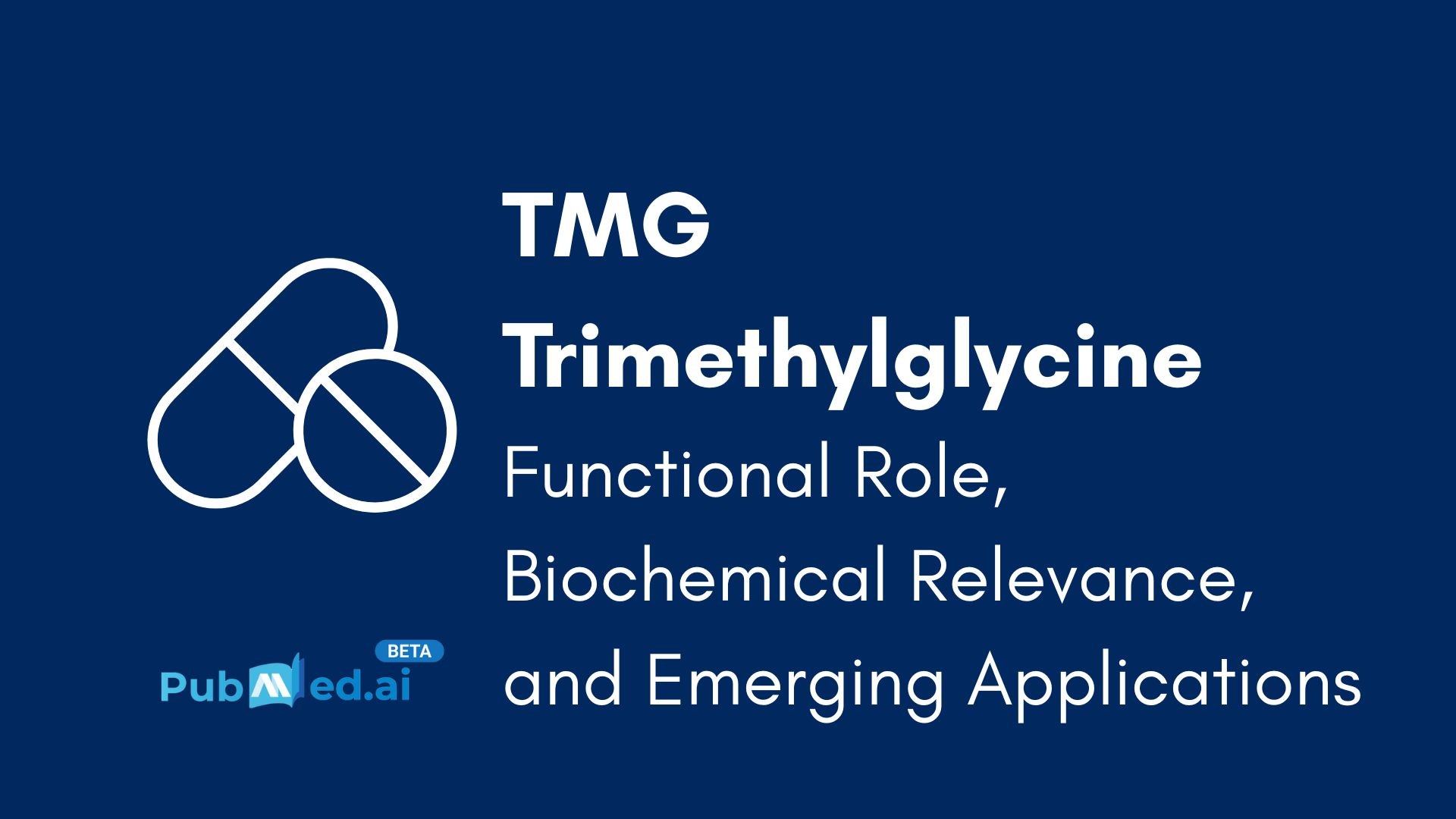TMG Trimethylglycine: Functional Role, Biochemical Relevance, and Emerging Applications

Trimethylglycine (TMG), a naturally occurring derivative of the amino acid glycine, is an important compound involved in numerous metabolic and physiological processes. While it is frequently referenced in the context of methylation and cardiovascular health, its functional scope extends beyond these domains.
TMG derives its name from the three methyl groups attached to its nitrogen atom, which confer its role as a methyl donor. It is structurally represented as (CH3)3N+CH2COO− and exists as a zwitterion at physiological pH. First isolated from sugar beets, TMG is also found in spinach, whole grains, and certain seafoods.
Search Trimethylglycine on PubMed.ai
What is Trimethylglycine?
Trimethylglycine (betaine) exhibits diverse benefits across multiple studies, demonstrating its role as an osmoprotectant, antioxidant, and anti-inflammatory agent. It enhances growth performance in poultry, reduces pro-inflammatory cytokines in clinical trials, and protects neuronal function in neurodegenerative models. Additionally, betaine aids in energy and antioxidant metabolism, contributing to better postharvest fruit quality in winter jujube and may hold therapeutic potential in various medical contexts.
Chemical Characteristics and Sources
Chemically, TMG is characterized by its zwitterionic form, which enhances solubility and stability in aqueous environments. Its presence in commonly consumed dietary sources such as beets, quinoa, and spinach makes it a nutritionally accessible compound.
TMG serves as a methyl donor in the remethylation of homocysteine to methionine via the enzyme betaine-homocysteine methyltransferase (BHMT). This reaction plays a crucial role in maintaining methylation balance, especially in individuals with impaired folate or B12 metabolism.
Biomedical Significance
The biochemical utility of TMG lies in its multifaceted physiological functions:
- Methylation Pathway Support: TMG acts as an alternate methyl donor, particularly in states of folate or B12 deficiency, providing resilience to methylation-dependent pathways.
- Homocysteine Regulation: Elevated plasma homocysteine has been implicated in cardiovascular diseases and neurodegenerative disorders. TMG's role in remethylating homocysteine is thus clinically significant.
- Hepatic Protection: Several studies indicate hepatoprotective effects of TMG, especially in non-alcoholic fatty liver disease (NAFLD), where it may prevent hepatic steatosis.
- Osmoregulation: As an organic osmolyte, TMG contributes to cellular volume regulation, protecting against environmental or metabolic stress.
The interplay of these mechanisms places TMG at the center of several investigative pathways in translational and clinical research.
Safety and Dosage Considerations
TMG is generally recognized as safe when used within recommended dosages. Clinical trials have documented tolerability at doses ranging from 500 mg to 6 g per day. Adverse events, although infrequent, include gastrointestinal discomfort and, in rare cases, insomnia or restlessness.
The safety profile remains favorable, though caution is advised in populations with altered methylation dynamics or those undergoing oncological treatment, where aberrant methylation may have clinical consequences.
Nutritional Supplementation and Ergogenic Potential
The commercial availability of TMG as a dietary supplement has prompted investigations into its ergogenic potential. Some formulations are marketed alongside B-complex vitamins, a combination that is biochemically coherent given their shared role in methyl metabolism.
Preliminary findings suggest that TMG may contribute to improved power output and endurance performance in athletes. The proposed mechanism involves enhanced creatine synthesis, facilitated through preservation of S-adenosylmethionine (SAMe) pools. However, large-scale, controlled trials are necessary to substantiate these findings.
Emerging Research: Epigenetics and Oncology
TMG's role in modulating methylation pathways has prompted interest in its potential influence on gene expression, particularly in the context of epigenetics and oncology. While some animal and cell studies suggest TMG may alter methylation patterns in genes involved in tumor suppression, human data are currently insufficient to form clinical guidelines.
Researchers investigating methyl donors in cancer models should consider the duality of TMG’s impact—its potential to restore methylation balance, but also the theoretical risk of promoting hypermethylation in oncogenic contexts.
Cognitive and Neurological Implications
Though less studied than other B-vitamins, TMG may play an indirect role in neurological function through homocysteine regulation. Elevated homocysteine levels are a known risk factor for cognitive decline. By facilitating homocysteine clearance, TMG may support neurotransmitter synthesis and neuronal health, although direct evidence remains limited.
Conclusion
Trimethylglycine is a biochemically versatile molecule with significant implications across various physiological systems. From its foundational role in methylation to its potential applications in hepatology, cardiovascular health, and exercise physiology, TMG merits continued investigation.
Researchers and students engaged in the biomedical sciences will find in TMG a compelling candidate for further exploration—both as a model compound in methylation dynamics and as a potential therapeutic adjunct.
Accelerate Your Research with PubMed.ai
PubMed.ai is an AI-powered research platform designed to streamline your academic workflow. Search biomedical literature, analyze full-text papers, summarize findings, and generate structured reports—all from a single intuitive interface.
Explore PubMed.ai
Frequently Asked Questions (FAQs)
What is TMG trimethylglycine used for?
TMG is primarily utilized to support methylation processes, reduce homocysteine levels, and promote cardiovascular and liver health.
What are the side effects of TMG trimethylglycine?
At standard dosages, side effects are rare but may include gastrointestinal upset and mild restlessness.
Can TMG trimethylglycine support muscle development?
Some early evidence suggests potential benefits in muscle performance, possibly via enhanced creatine synthesis, though further research is required.
Is there a connection between TMG and cancer?
TMG influences DNA methylation, which may affect gene expression. While preliminary studies have explored its role in oncology, conclusive clinical evidence is lacking.
What foods naturally contain trimethylglycine?
Beets, spinach, quinoa, whole grains, and certain seafood are natural sources of trimethylglycine.
Disclaimer:
This AI-assisted content is intended for academic reference and informational purposes only and does not constitute medical advice, diagnosis, or treatment. Always consult qualified healthcare professionals regarding any medical condition or treatment decisions. All risks arising from reliance on this content are borne by the user, and the publisher assumes no responsibility for any decisions or actions taken.

Have a question about medical research, clinical practice, or evidence-based treatment? Access authoritative, real-time insights: PubMed.ai is an AI-Powered Medical Research Assistant.
Your AI Medical Update
Subscribe to our free Newsletter